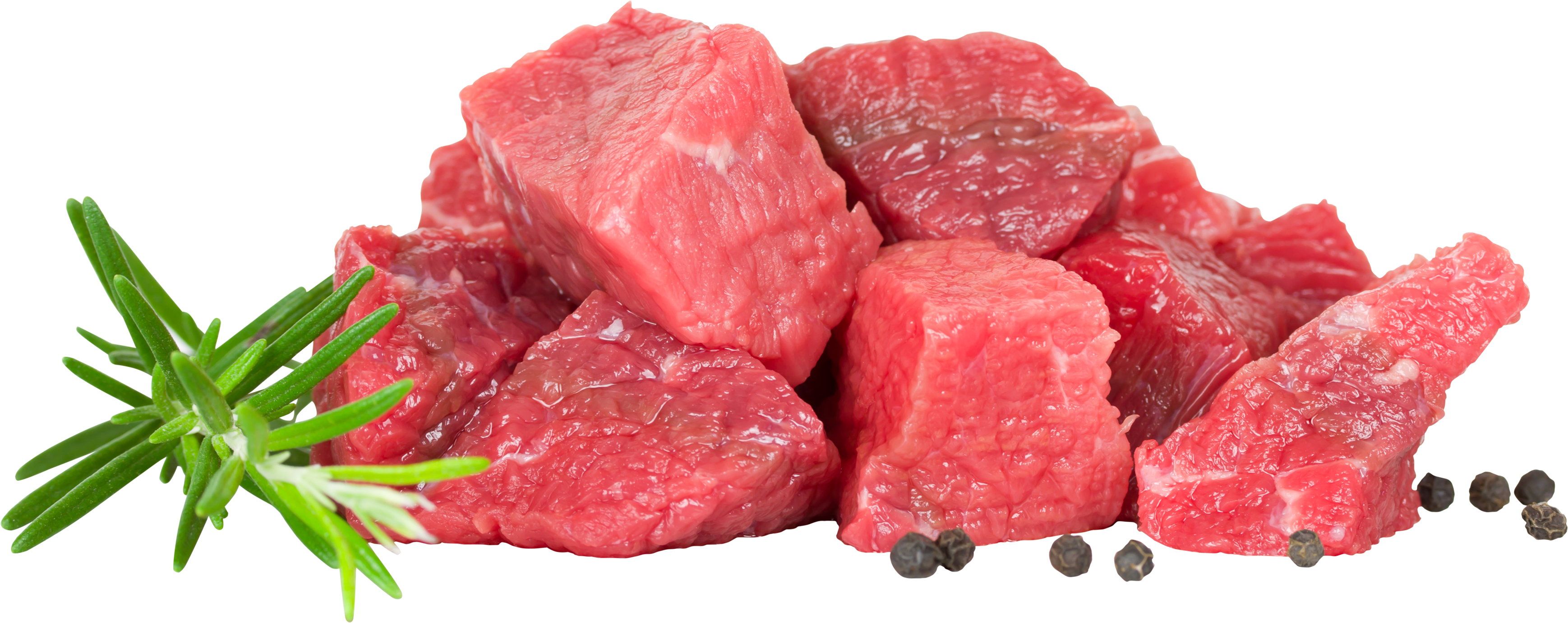
This image has format transparent PNG with resolution 3476x1380.
You can download this image in best resolution from this page and use it for design and web design.
Beef meat PNG with transparent background you can download for free, just click on download button.
Beef is the culinary name for meat from cattle, particularly skeletal muscle. Humans have been eating beef since prehistoric times. Beef is a source of high-quality protein and nutrients.
Most beef skeletal muscle meat can be used as is by merely cutting into certain parts, such as roasts, short ribs or steak (filet mignon, sirloin steak, rump steak, rib steak, rib eye steak, hanger steak, etc.), while other cuts are processed (corned beef or beef jerky). Trimmings, on the other hand, are usually mixed with meat from older, leaner (therefore tougher) cattle, are ground, minced or used in sausages. The blood is used in some varieties called blood sausage. Other parts that are eaten include other muscles and offal, such as the oxtail, liver, tongue, tripe from the reticulum or rumen, glands (particularly the pancreas and thymus, referred to as sweetbread), the heart, the brain (although forbidden where there is a danger of bovine spongiform encephalopathy, BSE, commonly referred to as mad cow disease), the kidneys, and the tender testicles of the bull (known in the United States as calf fries, prairie oysters, or Rocky Mountain oysters). Some intestines are cooked and eaten as is, but are more often cleaned and used as natural sausage casings. The bones are used for making beef stock.
Beef from steers and heifers is similar. Depending on economics, the number of heifers kept for breeding varies. The meat from older bulls, because it is usually tougher, is frequently used for mince (known as ground beef in the United States). Cattle raised for beef may be allowed to roam free on grasslands, or may be confined at some stage in pens as part of a large feeding operation called a feedlot (or concentrated animal feeding operation), where they are usually fed a ration of grain, protein, roughage and a vitamin/mineral preblend.
Beef is the third most widely consumed meat in the world, accounting for about 25% of meat production worldwide, after pork and poultry at 38% and 30% respectively. In absolute numbers, the United States, Brazil, and the People's Republic of China are the world's three largest consumers of beef; Uruguay, however, has the highest beef and veal consumption per capita, followed by Argentina and Brazil. According to the data from OECD, the average Uruguayan ate over 42 kg (93 lb) of beef or veal in 2014, representing the highest beef/veal consumption per capita in the world. In comparison, the average American consumed only about 24 kg (53 lb) beef or veal in the same year, while African countries, such as Mozambique, Ghana, and Nigeria, consumed the least beef or veal per capita.
In 2015, the world's largest exporters of beef were India, Brazil and Australia. Beef production is also important to the economies of Uruguay, Canada, Paraguay, Mexico, Argentina, Belarus and Nicaragua.
Beef production has a high environmental impact per gram of protein.
Beef is first divided into primal cuts, pieces of meat initially butchering. These are basic sections from which steaks and other subdivisions are cut. The term "primal cut" is quite different from "prime cut", used to characterize cuts considered to be of higher quality. Since the animal's legs and neck muscles do the most work, they are the toughest; the meat becomes more tender as distance from hoof and horn increases. Different countries and cuisines have different cuts and names, and sometimes use the same name for a different cut; for example, the cut described as "brisket" in the United States is from a significantly different part of the carcass than British brisket.
To improve tenderness of beef, it is often aged (i.e., stored refrigerated) to allow endogenous proteolytic enzymes to weaken structural and myofibrillar proteins. Wet aging is accomplished using vacuum packaging to reduce spoilage and yield loss. Dry aging involves hanging primals (usually ribs or loins) in humidity-controlled coolers. Outer surfaces dry out and can support growth of molds (and spoilage bacteria, if too humid), resulting in trim and evaporative losses.
Evaporation concentrates the remaining proteins and increases flavor intensity; the molds can contribute a nut-like flavor. After two to three days there are significant effects. The majority of the tenderizing effect occurs in the first 10 days. Boxed beef, stored and distributed in vacuum packaging, is, in effect, wet aged during distribution. Premium steakhouses dry age for 21 to 28 days or wet age up to 45 days for maximum effect on flavor and tenderness.
Meat from less tender cuts or older cattle can be mechanically tenderized by forcing small, sharp blades through the cuts to disrupt the proteins. Also, solutions of exogenous proteolytic enzymes (papain, bromelin or ficin) can be injected to augment the endogenous enzymes. Similarly, solutions of salt and sodium phosphates can be injected to soften and swell the myofibrillar proteins. This improves juiciness and tenderness. Salt can improve the flavor, but phosphate can contribute a soapy flavor.
Beef is a source of complete protein and it is a rich source (20% or more of the Daily Value, DV) of Niacin, Vitamin B12, iron and zinc.[65] Red meat is the most significant dietary source of carnitine and, like any other meat (pork, fish, veal, lamb etc.), is a source of creatine. Creatine is converted to creatinine during cooking.
In this page you can download free PNG images: Beef meat PNG images free download